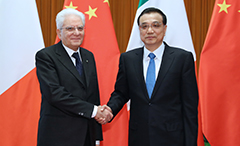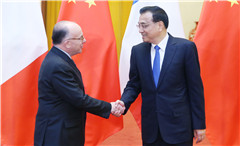China, Europe see deepened cooperation behind frequent exchanges
2017-02-25
Xinhua
BEIJING —Having visited both Beijing and Central China’s Wuhan city and signed agreements on nuclear energy and science, French Prime Minister Bernard Cazeneuve concluded his three-day official visit to China on Feb 23.
Meanwhile, Italian President Sergio Mattarella is half way through his state visit to China, which started on Feb 21. Both are making their first trip to China since taking office.
China is not only welcoming important visitors, but embracing cooperation with Europe.
FREQUENT HIGH-LEVEL EXCHANGES
“As relations between China and Europe become more important and influential, we see more high-level exchanges,” said Huang Ping, director of the Institute of European Studies of Chinese Academy of Social Sciences.
President Xi Jinping visited Switzerland in January, the first state visit to the European country by Chinese President in the 21st century. Then-Swiss President Johann Schneider-Ammann paid a state visit to China in April 2016, a year which saw meetings between leaders of China and European countries, including Belgium, Germany and Poland. The meetings raised the level of relations, including an innovative strategic partnership with Switzerland and comprehensive strategic partnerships with both Poland and Serbia.
Such frequent exchanges represent more consensus, according to Cui Hongjian, director of European Studies at the China Institute of International Studies.
“With leaders designing cooperation from a high level, these exchanges propel relations,” Cui said.
FIRM COOPERATION
An active and fruitful cooperation has been built up between China and Europe.
On Nov 5, 2016, a train entered Riga Central Station in Latvia, after traveling over 10,000 kilometers from East China’s Yiwu, the sixth freight train route from the city to Europe.
Under the umbrella of the Belt and Road Initiative, these freight trains to Europe made about 1,700 journeys in 2016, double the amount in 2015.
By freeing cooperation from geographical restrictions, both sides’ demands are better satisfied through the Belt and Road Initiative, Cui said.
Besides rail, China is linking to Europe in other ways, including a “16+1” summit between China and 16 Central and Eastern European (CEE) countries.
The summit has come up with new guidelines for cooperation each year since 2013. Last November in Riga, it concluded with a 28-item to-do list on cultural, health and local cooperation.
“The docking of various strategies are effective in exploring the large space for cooperation between China and Europe,” Huang said.
With cooperation boosted by these methods, trade value between China and EU grew by 3 percent from 2015 to over 3.6 trillion yuan ($525 billion) last year, a rather satisfying performance.
When talking with Premier Li Keqiang on Feb 21, Cazeneuve said France is ready to work with China to oppose protectionism. Mattarella supported an open multilateral trading system during his talks with President Xi on Feb 22.
Noting that Europe is vital to China’s opening-up policy, Cui said deepening cooperation is necessary. “European people need to see more tangible outcomes of cooperation to reduce trade protectionism in European countries.”


